We recently had the opportunity to review the QNAP TVS-EC1280U-SAS-RP 2U rackmount NAS unit. Since this is our first QNAP unit reviewed on STH, and this is a substantial machine, we are going split this review up into a few pieces. This first article is going to be hardware focused. Subsequent to this article we will look at the software ecosystem as well as the performance of the unit.
QNAP TVS-EC1280U-SAS-RP External Features
For the vast majority of QNAP users, the external portion of the chassis is all that one will ever have to interact with. The TVS-EC1280U-SAS-RP is a 2U rackmount form factor that can hold up to 12x 3.5″ drives. These drives can be 2.5″ or 3.5″ and either hard drives or solid state drives.
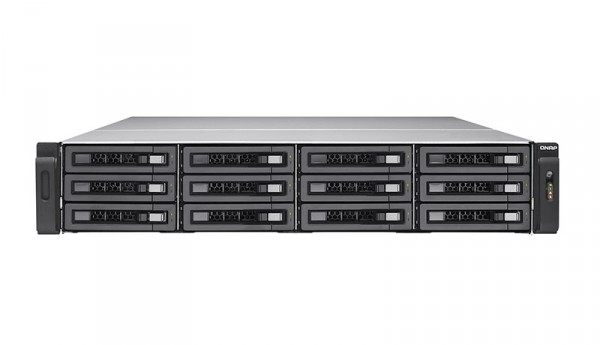
We did test the chassis using a mix of SAS and SATA hard drives and solid state drives and the unit was able to handle the mixed drive use case with ease thanks to its universal 3.5″ drive trays. The drive trays come equipped with blanks to improve airflow through the midplane chassis fans. One can use standard side mounting screws for 3.5″ drives and underside screws for 2.5″ drives using this tray. Each tray also features a locking mechanism to keep drives secure from an accidental removal.
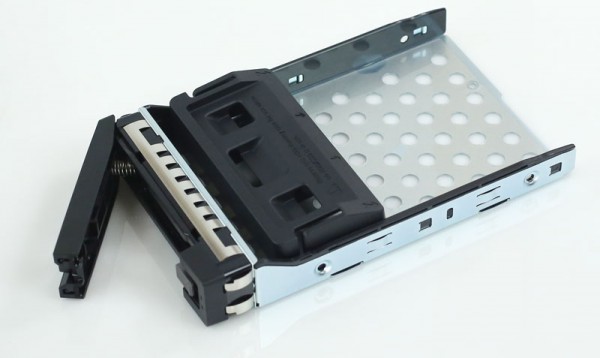
Rack mounting the unit was very simple. We did not have QNAP rails but the unit did work on our universal rail kit.
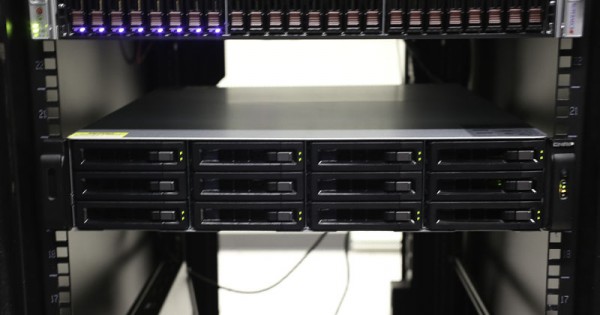
QNAP includes dual 450w power supplies which is more than ample for this class of machine. The dual power supplies allows one to take advantage of A+B power in datacenter environments. We did test single power supply operation both at 120V and 208V and the unit worked well (power consumption figures in our subsequent piece.)
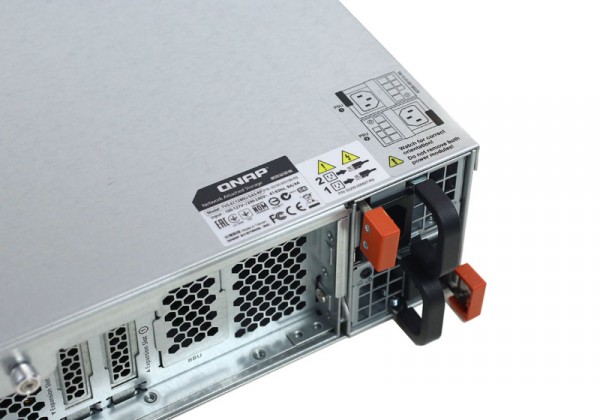
Rear I/O is quite extensive for a rackmount model. There are four 1GbE NICs which can be used for everything from LACP teaming to making the unit accessible on multiple networks simultaneously. There are four USB 2.0 ports as well as four USB 3.0 ports (blue).

We see there is a HDMI port for local video out. The next connector is a SFF-8644 12.0gbps connector which can be used to attach external disk shelves. We did not have additional shelves to test with the unit.
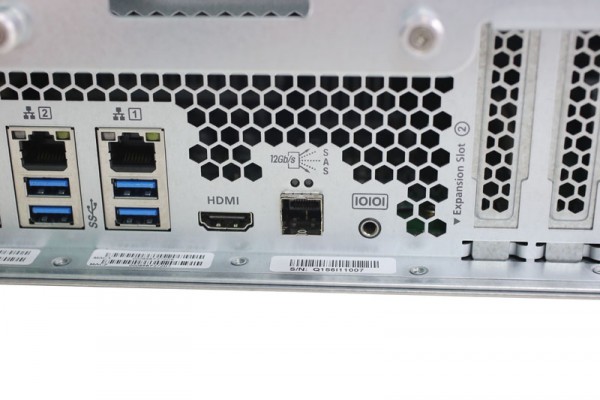
Finally there is a serial console connector. We would have preferred either an RJ-45 format for this since there is space on the rear I/O panel.
Installed in the rack, the unit is not overly deep at 28.9″. There are some datacenters that do have short depth 30″ racks as a budget option, but we would suggest this NAS would be an extremely tight fit. In most standard racks where one has 36″ or more, the unit will fit without issue. QNAP’s standard rack rails are intended for square holed racks not round so do keep that in mind when evaluating whether this unit will fit into your environment.
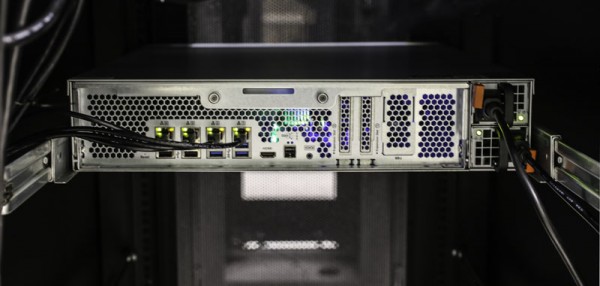
To access the motherboard tray, there are two external thumb/ Phillips head screws that must be unscrewed.
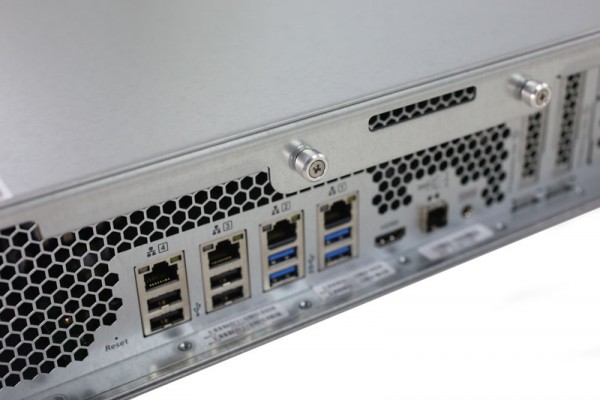
Once these are released, one can slide out the motherboard tray. This makes maintenance of the interior of the unit extremely simple. Furthermore, we were able to access components inside the chassis from the rear of the unit without having to slide the chassis out of the rack. From a serviceability standpoint, this feature is excellent and similar to what we would expect to find from higher-end NAS/ SAN units.
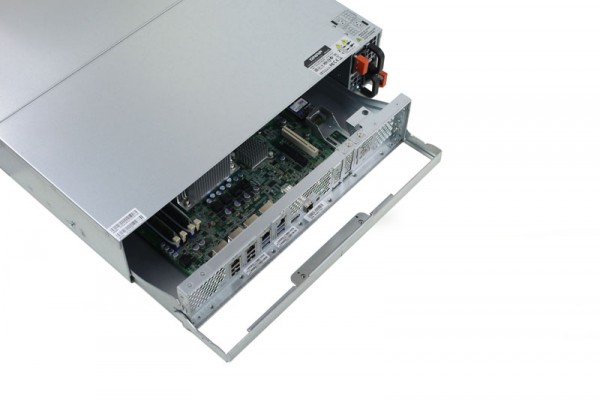
Now that we have looked at the exterior, the next step is to look at what is inside.
QNAP TVS-EC1280U-SAS-RP Internals
Moving to some of the internals, we mainly wanted to focus on what can be found on the internal motherboard tray.
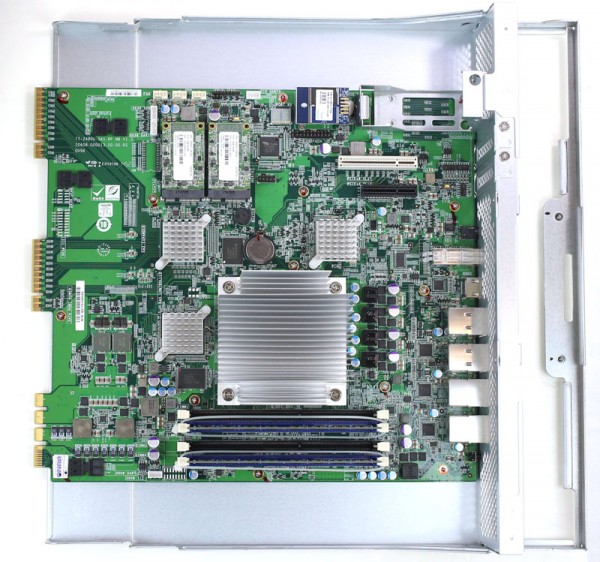
One can see the large passive Intel Xeon E3-1246 V3 heatsink which is more than enough to cool the 4 core/ 8 thread 84w TDP processor. Clock speeds are 3.5GHz based and 3.9GHz Turbo so this is a fairly quick processor. One can see the smaller Lynx Point PCH covered by a heatsink just above the CPU in this picture.
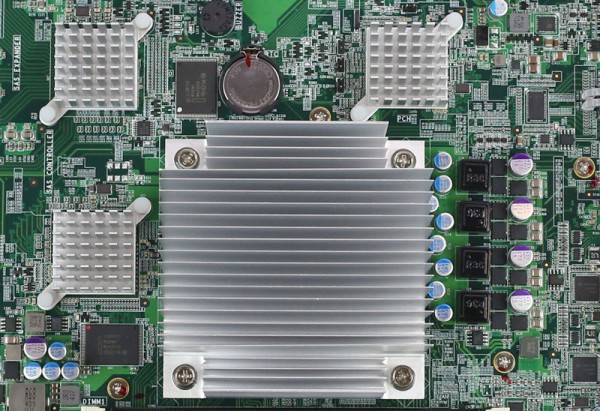
As a 16GB RAM unit, we see two 8GB DIMMs. The Haswell series supports up to 32GB of RAM so QNAP using slightly more expensive 8GB modules in a 2x 8GB configuration over a less expensive 4x 4GB configuration means that there is an easy upgrade path to 32GB if one wanted. QNAP has zip ties around the DIMM sockets to prevent movement during shipping and racking.
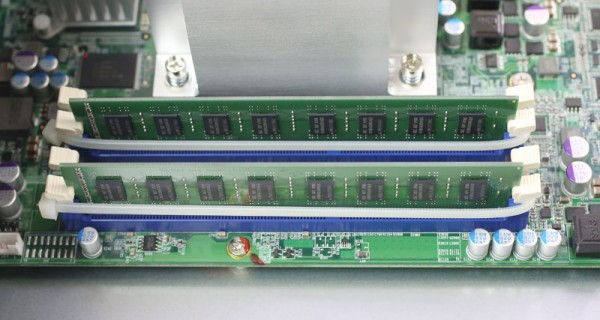
The four Ethernet NICs are Intel i210 which are the models that have replaced the Intel 82574L Gigabit Ethernet controllers. This is a premium component choice as each Intel i210 chip costs several times that of a Realtek Ethernet NIC. It is also a widely supported NIC and one of, if not the most popular 1GbE server NICs since replacing the 82574L a few years ago. Looking forward, we would have liked to have seen 10GbE onboard as this 2U NAS easily has enough horsepower to saturate dual 10GbE links and 10GbE switches are becoming much less expensive.
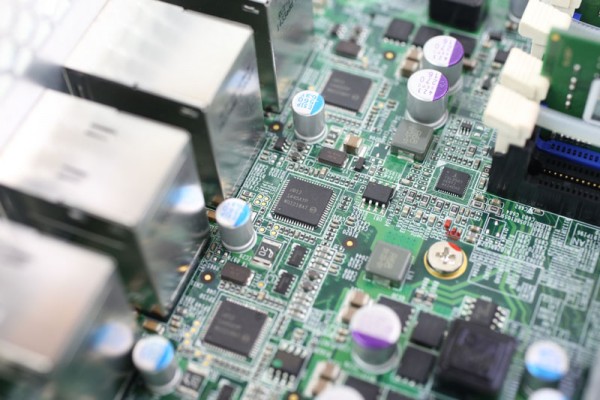
We do have components labeled SAS controller and SAS expander on the PCB. Between advertising DataBolt(TM) technology, which is a (LSI -> Avago now) Broadcom trademark, and a bit of searching documents, this seems to be a Broadcom SAS 3008 controller (or LSI SAS 3008 or Avago SAS 3008 if you want to search for more information on them.) As an 8 port controller, it does not natively have enough ports to service all of the 12 front ports plus the rear SFF-8644 port (4 ports), so the design is using a SAS expander to turn a single controller on a PCIe 3.0 bus into 12 SAS/ SATA lanes inside the chassis and another four outside of it.
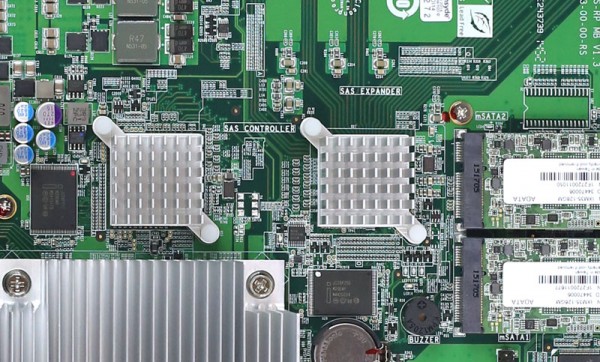
These SAS controllers are widely used and on the hardware compatibility lists of just about every major software operating system. There are less expensive options here but if we were building an architecture with an onboard SAS HBA and expander, we would recommend the SAS 3008. This is a great choice by the QNAP team.
Some of the “secret sauce” of the QNAP TVS-EC1280U-SAS-RP is the dual mSATA SSDs the unit has onboard. These two 128GB ADATA mSATA SSDs allow the unit to be filled with hard drives yet still have smart caching using QNAP’s QTS SSD cache feature.
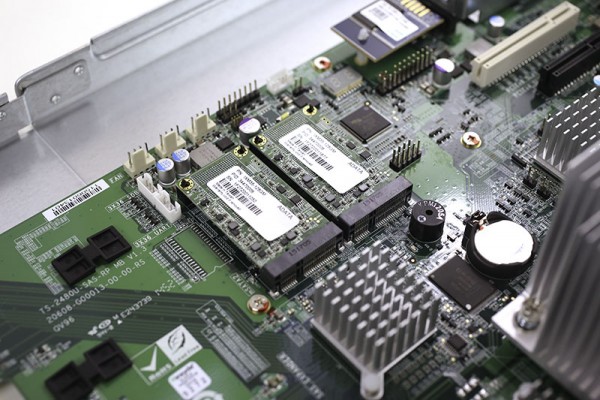
Next to the two mSATA SSDs we find an Apacer DOM. This module will generally hold OS storage.
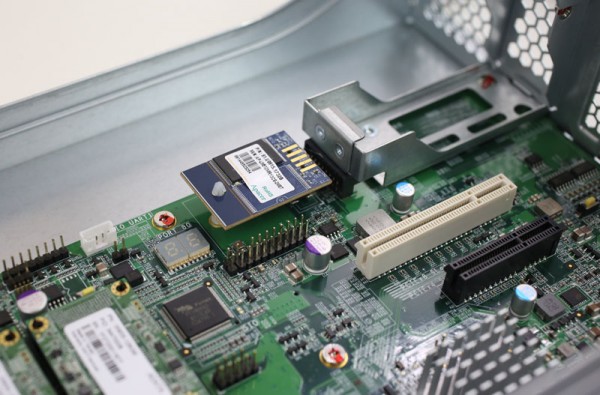
One can see next to the DOM there is a spot for a battery backup module (BBU). In chassis BBUs have become more popular over the past few years as battery capacities have risen. Our test unit was not equipped with this capability.
The QNAP TVS-EC1280U-SAS-RP has two PCIe expansion slots, one PCIe x8 and one PCIe x4. These expansion slots can be used to attach additional HBAs to expand the number of disks attached to the NAS unit, or can be used to attach higher speed networking. We understand that QNAP has both 10Gb and 40Gb Ethernet options.
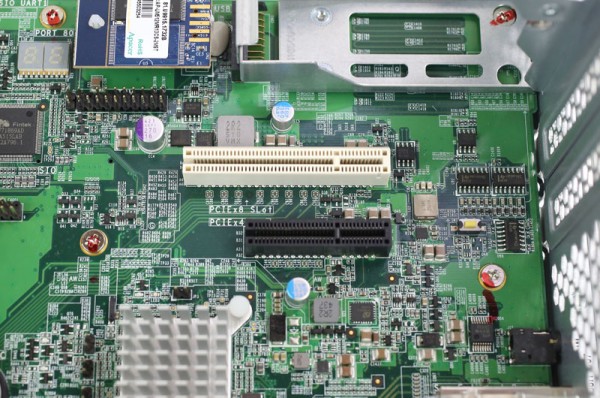
Finally, we found a 512MB Intel memory module onboard next to the CPU as well. It is nice to see QNAP continuing to use high quality components even in some of the more commoditized IC categories.
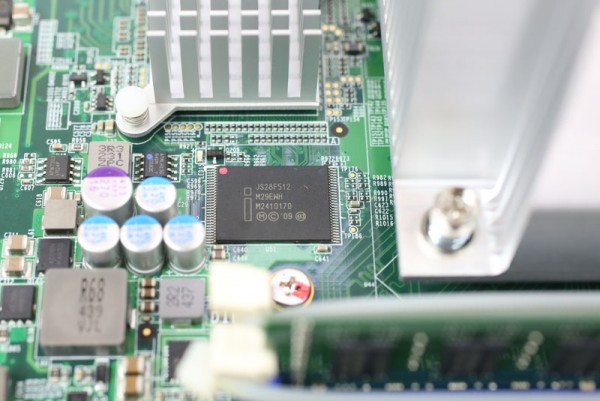
Wrapping-up Part 1 of the Review
From time to time, we get NAS units in the lab that cut corners by using lower-end components, the QNAP TVS-EC1280U-SAS-RP is not one of these instances. Instead, the QNAP TVS-EC1280U-SAS-RP uses many of the components we hand-pick when we build our own test servers. Components like Intel i210 gigabit Ethernet NICs cost a few dollars more than their Realtek counterparts, but they are known for being extremely reliable. Likewise, we were pleased to see the use of the SAS 3008 as the controller of choice. This is a higher-end SAS controller and is perhaps the most deployed 12gbps SAS HBA to date. Using high-quality components that have been proven in higher-end systems means that the drivers are mature and continue to mature over time. We have seen cases where lower cost Marvell controllers have meant incompatibilities but having run through stacks of drives with this machine, we can say it behaved as expected. The added serviceability of having a slide-out tool-less motherboard tray is more akin to what we see from higher-end NAS units than generic servers. Overall this unit performed extremely well for us and the value proposition put forth with the QNAP software suite is appealing. In the subsequent parts of this review we will look both at the performance and the software underpinnings which make the QNAP TVS-EC1280U-SAS-RP a strong contender.

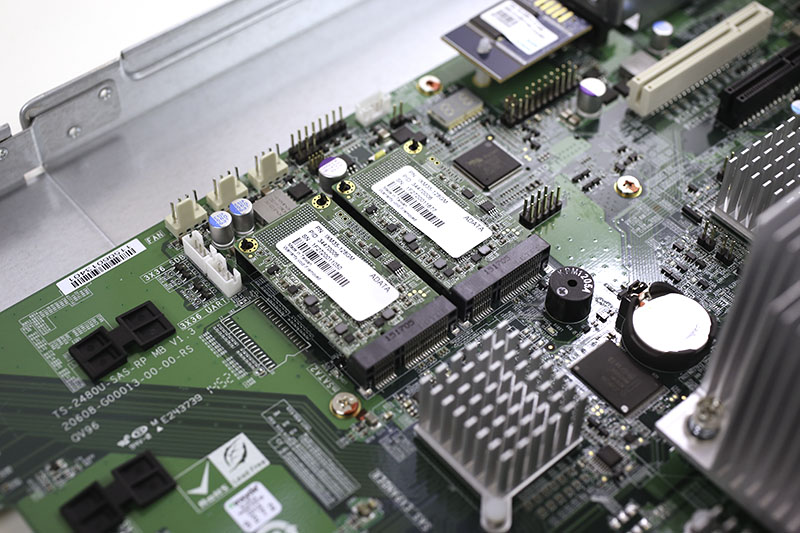


Does the system have ECC memory? I only see 8 chips on the side of the DIMMs visible in the picture.